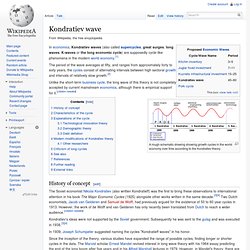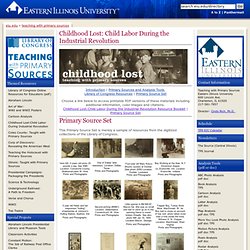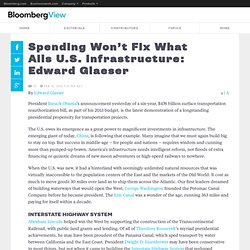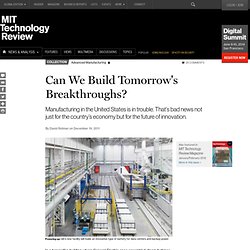

The Jewish Americans. THE JEWISH AMERICANS is a three-night documentary that explores 350 years of Jewish American history.

Written and directed by award-winning filmmaker David Grubin, THE JEWISH AMERICANS is a journey through time, from the first settlement in 1654 to the present. It is about the struggle of a tiny minority who make their way into the American mainstream while, at the same time, maintaining a sense of their own identity as Jews. Focusing on the tension between identity and assimilation, THE JEWISH AMERICANS is quintessentially an American story, which other minority groups will find surprisingly familiar. Narrated by actor Liev Schreiber, this landmark series features Jewish Americans who have made significant contributions to American life – from Louis D. Brandeis and Ruth Bader Ginsburg to Henry Morgenthau, Hank Greenberg, Betty Friedan, Molly Goldberg, Carl Reiner, Sid Caesar, and Tony Kushner.
Kondratiev wave. A rough schematic drawing showing growth cycles in the world economy over time according to the Kondratiev theory.

In economics, Kondratiev waves (also called supercycles, great surges, long waves, K-waves or the long economic cycle) are supposedly cycle-like phenomena in the modern world economy.[1] The period of the wave averages at fifty, and ranges from approximately forty to sixty years, the cycles consist of alternating intervals between high sectoral growth and intervals of relatively slow growth.[2] Unlike the short-term business cycle, the long wave of this theory is not completely accepted by current mainstream economics, although there is empirical support for it.
[citation needed] History of concept[edit] Kondratiev's ideas were not supported by the Soviet government. Innovation and the Bell Labs Miracle. But we idealize America’s present culture of innovation too much.

In fact, our trailblazing digital firms may not be the hothouse environments for creativity we might think. I find myself arriving at these doubts after spending five years looking at the innovative process at Bell Labs, the onetime research and development organization of the country’s formerly monopolistic telephone company, AT&T. Why study Bell Labs? It offers a number of lessons about how our country’s technology companies — and our country’s longstanding innovative edge — actually came about. Yet Bell Labs also presents a more encompassing and ambitious approach to innovation than what prevails today. Indeed, in the search for innovative models to address seemingly intractable problems like climate change, we would do well to consider Bell Labs’ example — an effort that rivals the Apollo program and the Manhattan Project in size, scope and expense.
Consider what Bell Labs achieved. The Wright Brothers In Flight. Childhood Lost: Primary Source Set. Childhood Lost: Child Labor During the Industrial Revolution Introduction | Primary Sources and Analysis Tools Library of Congress Resources | Primary Source Set Choose a link below to access printable PDF versions of these materials including additional information, color images and citations.Childhood Lost:Child Labor During the Industrial Revolution Resource Booklet | Primary Source Set Primary Source Set This Primary Source Set is merely a sample of resources from the digitized collections of the Library of Congress.

U.S. manufacturing sees shortage of skilled factory workers. But as the 2012 presidential candidates roam the state offering ways to “bring the jobs back,” many manufacturers say that, in fact, the jobs are already here.

What’s missing are the skilled workers needed to fill them. A metal-parts factory here has been searching since the fall for a machinist, an assembly team leader and a die-setter. Another plant is offering referral bonuses for a welder. And a company that makes molds for automakers has been trying for seven months to fill four spots on the second shift. “Our guys have been working 60 to 70 hours a week, and they’re dead. Through a combination of overseas competition and productivity gains, the United States has lost nearly 4 million manufacturing jobs in the past 10 years. Sonos Infographic: The History Of Radio. Spending Won’t Fix What Ails U.S. Infrastructure: Edward Glaeser. President Barack Obama’s announcement yesterday of a six-year, $476 billion surface transportation reauthorization bill, as part of his 2013 budget, is the latest demonstration of a longstanding presidential propensity for transportation projects.

The U.S. owes its emergence as a great power to magnificent investments in infrastructure. The emerging giant of today, China, is following that example. Many imagine that we must again build big to stay on top. Can We Build Tomorrow's Breakthroughs? Powering up: GE’s new facility will make an innovative type of battery for data centers and backup power.

In a hangarlike building where General Electric once assembled steam turbines, a $100 million battery manufacturing facility is being constructed to make products using a chemistry never before commercialized on such a large scale. The sodium–metal halide batteries it will produce have been tested and optimized over the last few years by a team of materials scientists and engineers at GE’s sprawling research center just a few miles away.
Now some of the same researchers are responsible for reproducing those results in a production facility large enough to hold three and a half football fields. The engineers have moved from the bucolic research center, which sits on a hill overlooking the Mohawk River, down to the manufacturing site, which abuts the river at the edge of Schenectady, New York, a working-class town known in its heyday as Electric City.